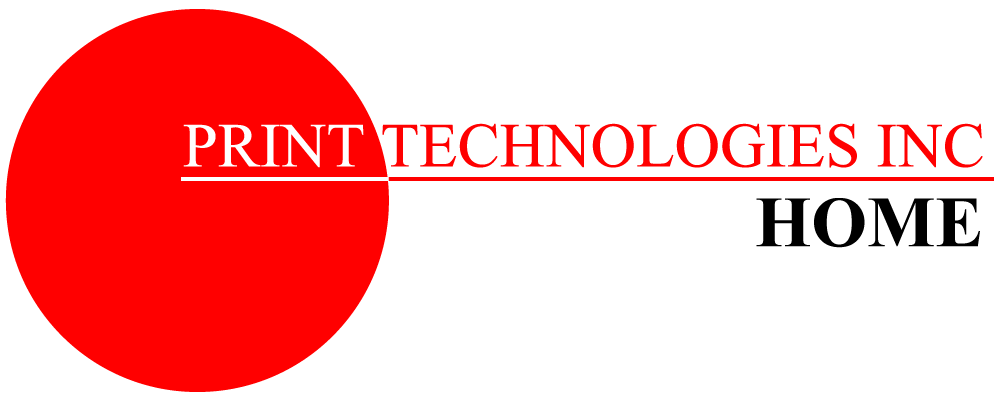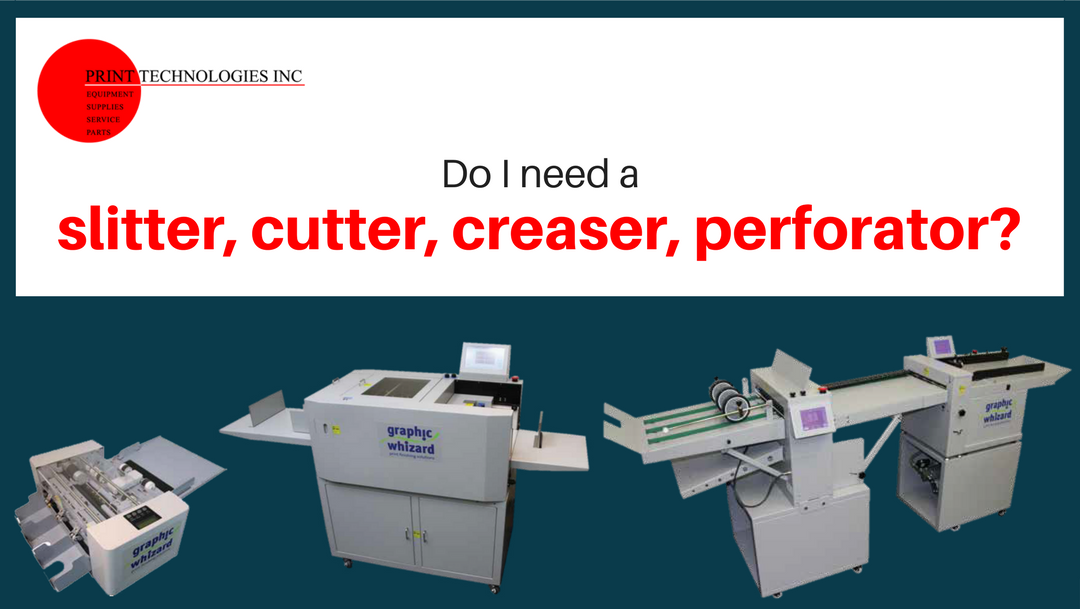Print Technologies has been selling and servicing many of the brands of slitter, cutter, creaser, perforator (SCC) machines that are currently on the market. Our staff has factory training on several of the current SCC machines and we work on many more (STANDARD, GRAPHIC WHIZARD, DUPLO, MBM, FORMAX, MORGANA, MBM/AEROCUT). This gives us a unique perspective to provide an insight into features and specifications of these machines. We hope we can help you make the decision, “Should I purchase an SCC and what questions to ask if I should want to purchase an SCC?”
Do I need a SCC?
Let’s start with the question of, “Do I need a SCC?” I want to first talk about each part of an SCC.
- Creasing. Creasing is accomplished by using a male and female die to stretch the fibers of the papers into a radius bend so to not crack the fibers of the paper of the surface of the toner.
- Scoring. The conventional method of “scoring” is accomplished by feeding the paper between two rotary dies. This method has a greater tendency to tear the fibers of the paper causing cracking in the paper and also cracking the toner.
- Slitting. Slitting is accomplished by using rotary slitters positioned to trim the paper in a lead edge to trail edge direction. This has traditionally been done with a guillotine cutter.
- Cutting. Cutting is accomplished by either a rotary or guillotine blade cutting the sheets in a side-to-side direction, operator to non-operator direction.
- Perforating. Perforating can usually be done both in vertical and horizontal directions. Strike perf, or Skip perf, is also available. Conventional perforating is done on a folder or rotary perf machine.
Since the introduction of the copier (Xerographic Process), cracking of the toner and the paper stocks have become more of a problem. Whether you resell the product that you produce or you print it for yourself, cracking can ruin the job and even cause the paper to split.
Creasing vs. Scoring
Let’s start with a definition: Is there a difference between Scoring and Creasing? Although not written in stone, there is a difference on how the scoring and creasing is produced. Through our discussion here, we will be talking about Rotary Scoring and Channel Creasing. Rotary Scoring is the age old method of a rotary score wheel that is pressed against a second wheel on two separate shafts. The paper is passed through the two, creating the score. This method is fast, but the problem is that as the rotary score wheel plows through the paper it can tear the fine fibers in the paper that lead to cracking when folded. Rotary Scoring, although good on some stocks, doesn’t always achieve the desired results. There are aftermarket scoring attachments that do work better than conventional score wheels but can still leave you with cracking.
Channel Creasing is the method in which you have a male and female die that is wider than the paper you are creasing. This method presses the paper in between the two dies, stretching the paper to the desired radius. This method is slower than Rotary Scoring but is more gentle on the paper and generally better results are achieved with a wider range of stocks.
Even though Channel Creasing is slower than the rotary creaser, most digital copier jobs are usually shorter runs. By the time you get the Rotary Score set up, the Creaser is finished with the job. Conventional Rotary Score machines are manually set up and can take more operator skill to set up. The modern Creasing machines can be programmed in seconds with minimal operator skills. Even the depth of the Crease can be programmed into the Creasing machines. Creasing can still have an advantage on certain stocks ran on an offset press too. If you have the time, Creasing is no doubt the best way to give you the best results.
The end result is what is important. As more run lengths become shorter, the Xerographic process makes more sense to use and Channel Creasing makes more sense to give you the best and most consistent end result.
Slitting and Cutting
Slitting and cutting on a SCC is becoming more popular and more desired. Using a paper cutter to cut reams of paper in a single swipe, works great when the registration of the job is consistent. Offset presses give the consistent registration that is needed when the cutting must be accurate. Unfortunately, copier/digital printers/xerographic processes are not so accurate. Even though the registration has improved over the years, these digital devices are not always consistent on the varieties of stocks that we print on today. If the registration is off even half a percent, the results on properly cutting a multiple up job can be disastrous on a paper cutter. The other problem is that digital printers can enlarge or shrink the image on the sheet.
The SCC ‘s have a built-in feature that allows the SCC to increase or decrease the step and repeat cut to compensate for the inaccuracies of the digital printers. If the image enlarges or shrinks in length or width, the SCC’s can adapt quickly to solve the problem. If the image shifts on the sheet, most of the SCC’s on the market have an OMR reader. An OMR mark can be printed on every sheet and the SCC can adjust the imposition registration on every sheet. Not something that can be done with a guillotine cutter.
Perforating
My favorite! It used to be difficult to do a “T Perf”. The given method was to use a Die, made for the job, or mount Perf Strips on a back cylinder on a small press. Both methods were slow to set up or manufacture and took operator skills.
Not anymore. With the newer SCC’s, you can now add a strike perf, (up to 4 on some machines) along with a cross perf, and get a beautiful “T Perf” anytime with ease. This allows you to perf as many cross perfs that you like and add in the Strike Perf to start and end the perf anywhere on the sheet. This function can easily be added to a program for repeatability. You can also do simple perfs, vertically or horizontally.
The Perf function can bring in the business that you don’t have with a faster turnaround than imaginable.
To answer the question, “DO I NEED A SCC: Slit, Cut, Crease, and Perf machine?”
- If you run digital printers, the answer is yes.
- If you have experienced cracking stock or toner, the answer is yes.
- If you have difficulty cutting multiple up cards on the cutter because of registration or image sizing problems, the answer is yes.
- If you ever have the need to perf or create unlimited “T Perfs”, the answer is yes.
- Is it difficult to get operators than can run your older technology? The answer is yes.
- Are your run lengths getting shorter and shorter? The answer is yes.
- Are you printing on more variety of heavy stocks? The answer is yes.
- Do you repeat Slit, Cut, Crease and Perf jobs? The answer is yes.
- Are you constantly creating new Slit, Cut, Crease and Perf jobs? The answer is yes.


0 Comments